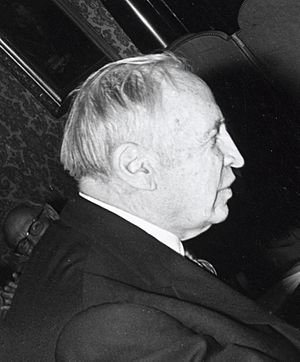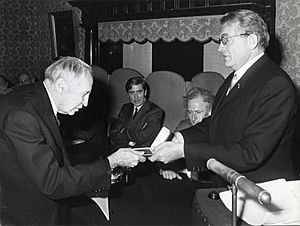John Hasbrouck Van Vleck facts for kids
Quick facts for kids
John Hasbrouck Van Vleck
|
|
|---|---|

John Hasbrouck Van Vleck, 1974
|
|
| Born | March 13, 1899 |
| Died | October 27, 1980 (aged 81) |
| Nationality | United States |
| Alma mater | University of Wisconsin–Madison Harvard University |
| Known for | Van Vleck paramagnetism, Van Vleck transformations, Van Vleck formula |
| Awards |
|
| Scientific career | |
| Fields | Physics |
| Institutions | University of Minnesota University of Wisconsin–Madison Harvard University University of Oxford Balliol College, Oxford |
| Doctoral advisor | Edwin C. Kemble |
| Doctoral students | Robert Serber Edward Mills Purcell Philip Anderson Thomas Kuhn John Atanasoff Arianna Rosenbluth |
John Hasbrouck Van Vleck (March 13, 1899 – October 27, 1980) was an American physicist and mathematician. He was co-awarded the Nobel Prize in Physics in 1977, for his contributions to the understanding of the behavior of electrons in magnetic solids.
Education and early life
Born in Middletown, Connecticut, the son of mathematician Edward Burr Van Vleck and grandson of astronomer John Monroe Van Vleck, he grew up in Madison, Wisconsin, and received an A.B. degree from the University of Wisconsin–Madison in 1920. Then he went to Harvard for graduate studies and earned a Ph.D degree in 1922.
Career and research
He joined the University of Minnesota as an assistant professor in 1923, then moved to the University of Wisconsin–Madison before settling at Harvard. He also earned Honorary D. Sc., or D. Honoris Causa, degree from Wesleyan University in 1936.
J. H. Van Vleck established the fundamentals of the quantum mechanical theory of magnetism and the crystal field theory (chemical bonding in metal complexes). He is regarded as the Father of Modern Magnetism.
During World War II, J. H. Van Vleck worked on radar at the MIT Radiation Lab. He was half time at the Radiation Lab and half time on the staff at Harvard. He showed that at about 1.25-centimeter wavelength water molecules in the atmosphere would lead to troublesome absorption and that at 0.5-centimeter wavelength there would be a similar absorption by oxygen molecules. This was to have important consequences not just for military (and civil) radar systems but later for the new science of radioastronomy.
J. H. Van Vleck participated in the Manhattan Project. In June 1942, J. Robert Oppenheimer held a summer study for confirming the concept and feasibility of a nuclear weapon at the University of California, Berkeley. Eight theoretical scientists, including J. H. Van Vleck, attended it. From July to September, the theoretical study group examined and developed the principles of atomic bomb design.
J. H. Van Vleck's theoretical work led to the establishment of the Los Alamos Nuclear Weapons Laboratory. He also served on the Los Alamos Review committee in 1943. The committee's important contribution (originating with Rose) was a reduction in the size of the firing gun for the Little Boy atomic bomb, a concept that eliminated additional design weight and sped up production of the bomb for its eventual release over Hiroshima. However, it was not employed for the Fat Man bomb at Nagasaki, which relied on implosion of a plutonium shell to reach critical mass.
In 1961/62 he was George Eastman Visiting Professor at University of Oxford and held a professorship at Balliol College.
In 1950 he became foreign member of the Royal Netherlands Academy of Arts and Sciences. He was awarded the National Medal of Science in 1966 and the Lorentz Medal in 1974. For his contributions to the understanding of the behavior of electrons in magnetic solids, Van Vleck was awarded the Nobel Prize in Physics 1977, along with Philip W. Anderson and Sir Nevill Mott. Van Vleck transformations, Van Vleck paramagnetism and Van Vleck formula are named after him.
Van Vleck died in Cambridge, Massachusetts, aged 81.
Awards and honors
He was awarded the Irving Langmuir Award in 1965, the National Medal of Science in 1966 and elected a Foreign Member of the Royal Society (ForMemRS) in 1967. He was awarded the Elliott Cresson Medal in 1971, the Lorentz Medal in 1974 and the Nobel Prize in Physics in 1977.
Personal life
J. H. Van Vleck and his wife Abigail were also important art collectors, particularly in the medium of Japanese woodblock prints (principally Ukiyo-e), known as Van Vleck Collection. It was inherited from his father Edward Burr Van Vleck. They donated it to the Chazen Museum of Art in Madison, Wisconsin in 1980s.
See also
 In Spanish: John Hasbrouck van Vleck para niños
In Spanish: John Hasbrouck van Vleck para niños


